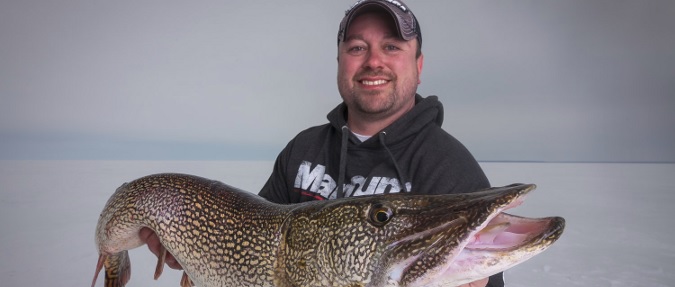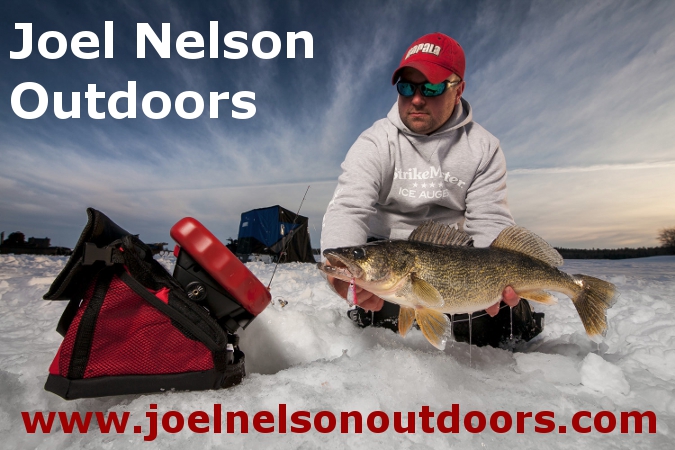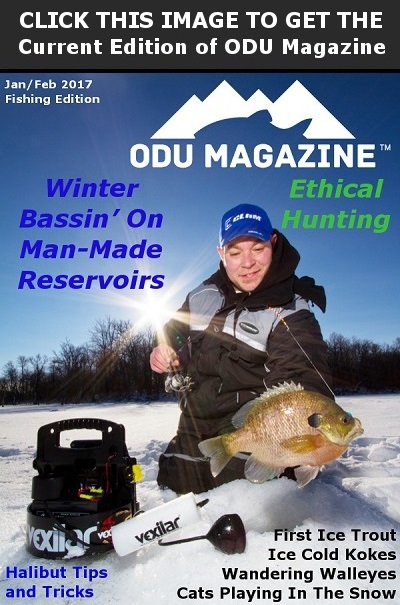A Multi-Species Approach……. Have you ever gone fishing and caught something completely un-intended? A few years back we were headed to a small lake in northern MN to film a purported basin bite for spoon-eating crappies. Excited to tie into the 14”+ brutes we’d seen pictures of, we drilled out the small basin area and found nothing. Zero. Not a single fish marked. As we pushed shallower, we saw on the flasher what looked like a weedbed absolutely loaded with them, or so we thought. For the first half hour, our spoons and any other hard bait were repeatedly denied, with the exception of several unusually large bass. Getting ready to leave our newfound largemouth hotspot on a well-known crappie lake, I decided to drop a small teardrop and euro-larvae combination, and the rest is history. It turned out to be one of the better late-ice bull bluegill bites I’ve been on, and ended up being a great show.

One of the keys to catching more fish is simply to fish in a way that includes more potential species, but that can be tough to do. We hit the ice with pre-determined conceptions about walleye-lake this, good-crappie-population that, and forget that each spot is a new adventure and potentially a “new” fish. It makes sense, as we’ve specialized a great deal in the last decade. We use ultra-sensitive noodle rods for finicky gills, consider line choice based on what size and species we’d like to target, and even fish particular areas that are considered “classic” for walleyes, crappies, and any other range of fish species. Whether you’re parked in a wheel-house over a crappie-hole or you’re punching holes in the shallows looking for weed-bed bluegills, here are some great ways to be an equal-opportunity angler once you start marking fish on the graph.
Top-Two Lure Types
Not any one bait can target everything well, but you’ll do yourself a great favor in fishing lure types and sizes that work well in a variety of situations, for a number of different species. An 1/8 oz. spoon in about any variety, provided the hooks are not too large, will catch nearly everything that swims in most freshwater lakes during the winter. Another top pick is the #3 Jigging Rap, as it’s something I have tied on at least one rod full-time. No matter where I fish and for what, each of these lure types are nearly always in play. Choose attractor type colors and patterns for general appeal in pinks, reds, and greens, and you’ll simply catch more fish wherever you go.
Down-Typing
Downsizing has become almost cliché in fishing advice columns, but so often anglers won’t go far enough to ensure they get bit. Switching from ¼ oz. spoons to 1/8 oz. varieties may work when trying to cover both Perch and Walleye bites, but what if the walleye you think you’re marking is really a crappie? In that case, switching to a tiny glow jig and plastic combination may be much more appropriate.
Know Thy Fish
I tend to start with larger aggressive lures, but closely study the reactions and aggressiveness of the first few fish that come onto the flasher. Walleyes and perch that are actively feeding will often rise, retreat, and revisit the bait quickly, several times before eventually eating. Crappies tend to school in the winter, and even when they come in as singles will often simply appear at the same height as your offering. Good bluegills will rise and back away very methodically. I could go on and on, but the point is that each species has its own calling card.
Nothing prepares you for the above tactic like watching fish with an underwater camera, and species-specific identification will help you to select the best baits and methods to catch them. Especially in river-systems, fish are very often assumed to be a species they are not. More diversity offers simply more opportunities to get it wrong. Even in lakes, or within the same species, there’s a big difference between large marks that can either be wads of bait perch, or a single tiger of the 11-12” variety we’re all interested in catching more of.
Bait Selection
When targeting species of all types, it pays to have a variety of bait. Often, a detail as small as minnow size can inhibit a crappie from inhaling the overly large fatheads you’re presenting. Similarly, walleyes in the 20” plus category often prefer a more substantial snack in the form a light-pike sized sucker minnow or larger shiner. However, fish only those baits, and you’re actively selecting against smaller walleyes and other species that may not be willing to eat something that large.
Diversify Your Spread
Large groups in permanent shelters though immobile, have a distinct advantage to running more lines in that they can offer a wider array of baits. When fishing for action and numbers, here is my typical lineup.
· Active jigging rod with a search bait – Rattlebaits or any other noisy offering that puts vibration or lots of flash in the water column
· Active jigging rod with a #3 Jigging Rap
· Active jigging rod with an 1/8 oz. flutter or flash spoon tipped with minnow head
· Active panfish jigging rod with a tungsten and plastic
· Active panfish jigging rod with micro tungsten and bait
· Stationary setup #1 – Free-swimming fathead on a small glow jig
· Stationary setup #2 – Free-swimming crappie minnow on a small fine wire hook
· Stationary setup #3 – Free swimming light pike sucker or
Be prepared to adapt on ice, switch to the productive tactic of the moment, and use multi-species techniques to bring more fun and success to your mid-winter fishing.
By Joel Nelson Outdoors


